Place: Trail of 100 Giants, Johnsondale, California
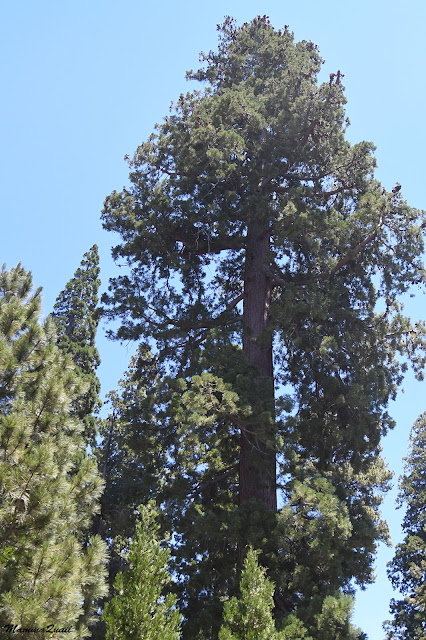 |
| Giant Sequoia, Sequoiadendron giganteum |
 |
| Our hike as captured by my GPS |
It is nearly impossible to take a complete photo of a full grown giant sequoia from close distance. The grove of 100 Giants however, has sequoia of many ages, ranging from saplings to millennia old trees. Amobg the sequoia were also cedars, pines, and a few broad leaf trees, such as oaks.
The trail begins across the road from the parking lot with a huge sequoia tree, estimated to be over 2000 years old and measured 245 ft tall, 62 ft around, and 18 ft in diameter. A sign next to the tree said that at this very place President Clinton created the Giant Sequoia Monument within the Sequoia National Forest. An interesting anecdote in this context that the Trail of 100 Giants is a Bureau of Land Management (BLM) land and isn't actually managed by the Sequoia National Forest. People lined up to go and take their photos next to the massive trunk, and went in and out of the hole at its base. I contemplated doing the same but the waiting line was too long and Pappa Quail had already moved down the trail so I gave up and followed him down the trail.
I had an easier time taking the length of sequoia that were further away, and also somewhat lower on the trail. Still couldn't get the entire length, though.
 |
| Giant Sequoia, Sequoiadendron giganteum |
One thing that amazed me from the beginning and throughout the hike, especially in this crazy heat wave, was how many ferns were growing at the forest floor, and how lush and healthy they looked. Although I've seen plenty of dry land ferns in many places, I still tend to associate them with dark and damp environments. 
The forest undergrowth wasn't extensive at all, but it also wasn't empty. A number of hardy-looking plants were thriving below the giant sequoia trees, and many of them were in bloom.
 |
| Sierra Lotus, Acmispon decumbens |
Some of these plants had such little flowers that I had to stoop really low to get a decent photograph. I didn't kneel though, it was too hot to try hard at anything.
 |
| Sierra Lotus, Acmispon decumbens |
I caught up with Pappa Quail while he was standing in the shade, photographing a bird that was hopping on the ground nearby. The bird was quite close to us and completely unbothered by our presence, so I too took some photos. This is one of the rarely few occasions when both Pappa Quail and me photographed the same bird and my photo turned out better.
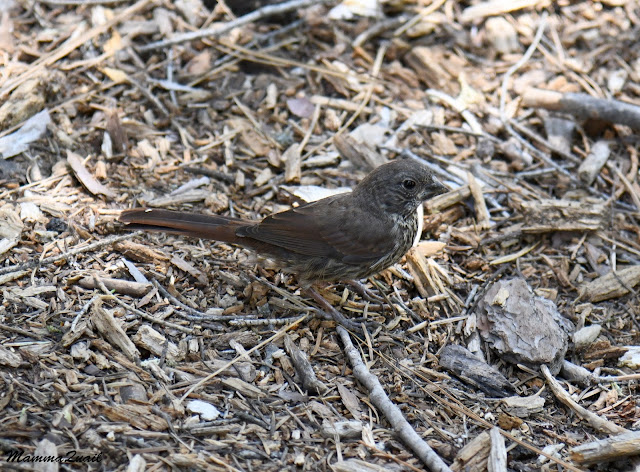 |
| Fox Sparrow |
The chipmunk was further away though, and Pappa Quail's lens was better suited to handle that distance.
 |
| Alpine Chipmunk |
The giant sequoia grove was growing on a very mild hilly slopes and at the creases between them grew creek vegetation, even in places where the water wasn't running anymore. Flatter areas were covered with lush, green meadow plants. One of these plants was the Sierra bog orchid, a lovely sighting whenever I find it.
 |
| Sierra Bog Orchid, Platanthera dilatata var. leucostachys |
Some of the creek side wildflowers were new to me, like the white-flowered willowherb. I didn't know that at the time though, otherwise I'd have bothered to take better photos.
 |
| White-flowered Willowherb, Epilobium lactiflorum |
After I stopped getting distracted by the little forest life, I turned my attention once more to its true monarchs - the giant sequoia. It was easy enough to tell the older sequoia from the nearby pines and cedars. Their canopies were huge, expanded in every dimension.
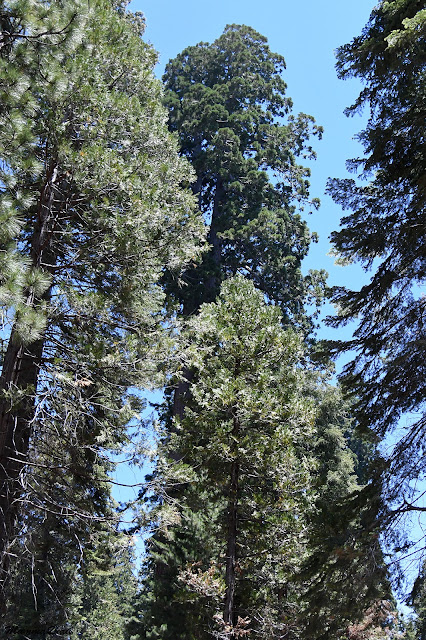 |
| Giant Sequoia, Sequoiadendron giganteum |
The giants were recognizable not only by their canopies but also by their massive trunks. The one in the photo below is in fact, two sequoia trees that are in the process of fusing with one another. Photographed with a human for scale :-)
The living part of the tree, of any tree, is its bark. The tree bark keeps growing, adding girth (tree rings) throughout's the tree's life. When encountering obstruction, the back simply grows around it. A pair of trees near the trail showed this beautifully - a cedar tree was growing too close to a giant sequoia, and the sequoia's bark is slowly but surely engulfing the cedar's trunk. A sign posted by the pair informed the public of this process, without giving any prediction as to wether this would eventually harm the cedar, in the long run. Unlike the fusing sequoia pair in the higher photo, these trees of different species will not fuse their barks.
 |
| Giant Sequoia 'hugging' Incense Cedar |
Younger sequoia however, are more difficult to recognize because, not only don't they have the size yet, but their shape is also more of a generic conifer shape. A bit of foliage comparison though, and even the younger sequoia can be identified in the forest's crowd.
Three years ago a huge fire ravaged this area of the Sierra Nevada. All around the Trail of 100 Giants, the forest was pretty much gone. It was pretty obvious that this sequoia grove was saved because of human effort. As we started making our way up the southern loop of the trail we could see the fire damage beyond the preserve's boundaries.
The map at the beginning of the trail showed the southern loop trail to be disrupted, because the boardwalk at its higher part was destroyed by the fire. We decided to go up to the trail block and see what was there. There were fewer wildflowers on the higher part of the trail.
 |
| Pine Drops, Pterospora andromedea |
The damaged boardwalk was spanning a shallow creek with a big area flanking it. A chain and a big board post sign barred the trail. A bit off to the side was a fallen dead sequoia giant, its root crown rising high into the air. We lamented the fallen monarch for a couple of minuets then turned around to walk back to the main loop trail.
 |
| Giant Sequoia Root Crown |
Pappa Quail noticed a movement on one of the cedar trunks - it was a brown creeper. We paused there for a while to look at the little bird as it skillfully moved up the trunk than flew to the base of the next tree over, and started climbing that one too, plucking out little bugs from the tree bark and swallowing them on the go.
 |
| Brown Creeper |
A chipmunk was doing similar foraging movement nearby, only horizontally, on the ground. The chipmunk was much more wary of us than the creeper was.
 |
| Alpine Chipmunk |
We reconnected with the main loop going towards the north side loop trail. Ahead of us loomed one of the older, more massive sequoia trees in this grove, measuring 225 ft tall, and 20 ft in diameter.
 |
| Giant Sequoia, Sequoiadendron giganteum |
This giant sequoia had a dead top, destroyed by lightning, according to the sign posted next to it. Losing the top is common among tall trees - they grow up until they become the tallest thing in their locale, and become a lightning rod.
The lower part of the trail run along a nice meadow full of wildflowers. Most of these wildflowers were the Bigelow's sneezeweed (the sign there said black-eyed Susan, but that's a different plant). Thankfully I didn't sneeze.
 |
| Bigelow'S Sneezeweed, Helenium bigelovii |
Here and there in the meadow were other wildflowers as well, such as the California cornlily. The cornlilies love wet places and it's possible the creek was running tere belw al that vegetation.
 |
| California Cornlily, Veratrum californicum |
Another giant sequoia loomed ahead on the trail - this one was not a young tree but it wasn't one of the old ones either - it still had its live and healthy top and the classic conifer cone shape.
 |
| A younger Giant Sequoia, Sequoiadendron giganteum |
We came along the creek when we were past the meadow. Some water was still flowing there, but not much. There were little pools of standing water at the edge of the creek and soon enough we felt the mosquitos coming at us. It was time to put on the deet.
The creek side was where we saw numerous other wildflowers such as the Kelley's lily, a close relative of the tiger lily. The lilies attracted butterflies, which seemed to enjoy the heat.
 |
| Kelley's Lily, Lilium kelleyanum |
Monkeyflowers also bloomed at the creek side. There are several monkeyflower species that look very much alike, and this one in the photo below, if I did not mistaken the species identity, was a lifer for me.
 |
| Monkeyflower, Erythranthe corallina |
A bench was placed by the creek and next to it was a serenity sign inviting visitors to rest there and reflect about what was learned on the walk among the sequoias. Well, the bench was in the shade and we were both dripping sweat so we did sit there for a few minutes. From the bench we could see the low bridge where we were about to cross the creek to get to the north loop trail.
Another patch pf the sneezeweed lit our way to the bridge. It was lovely to see these little sunflowers brightly contrasting the tree shadows behind them.
Never forgetting that the giant sequoia were the real stars of this place, we paused by the bridge and looked at the grove right ahead of us. These were a bit younger sequoia, very tall and impressive even without the complex, massive top.
 |
| Giant Sequoia, Sequoiadendron giganteum |
A few broad leaf trees grew here and there throughout the sequoia grove. Most of these were oak trees, wearing the fully expanded green foliage of the height of summer.
 |
| California Black Oak, Quercus kelloggii |
Pappa Quail spotted a warbler in one of the nearby cedar trees and stopped there for a while to observe the bird. Yellow-rumped warblers are common enough in the Bay Area, but the Audubon variety isn't one we see frequently.
 |
| Yellow-rumped Warbler, Audubon variety, Adult, breeding |
An old giant sequoia loomed ahead of us, just before the trail junction with the north loop. This massive tree was slanting, and I expect that at some point it'll topple over. I hoped it won't be while we were walking underneath it.
 |
| Giant Sequoia, Sequoiadendron giganteum |
The canopy of this giant sequoia was huge and complex - each of its branches was as large as a large tree on its own. It was like seeing an entire small forest growing at the top of a single trunk.
 |
| Giant Sequoia, Sequoiadendron giganteum |
I was beginning to feel my neck, looking up at all the beautiful giant sequoia canopies. We walked to where the south loop junction with the main loop was, but decided to not go up that side of the trail to get to the trail blockage on the other side.
 |
| Giant Sequoia, Sequoiadendron giganteum |
Instead, we continued toward the junction with the north loop trail, where a nice patch of lupine bushes was blooming by the trail side.
 |
| Broad-leaf Lupine, Lupinus latifolius |
These broad-leaf lupines were at the peak of their bloom season. I didn't see butterflies there, but there were quite a lot of bees buzzing around the open flowers.
 |
| Broad-leaf Lupine, Lupinus latifolius |
Nearby bloomed also the crimson columbine - the beautiful common relative of the Sierra columbine that I found at the summit of Sherman Peak two days before.
 |
| Crimson Columbine, Aquilegia formosa |
Sequoia trees are pretty much immune to pests. Their extremely thick bark that is rich with tannins seems to deter any wood-eating bugs and fungi. Other beings however, do make use of the sequoia wood, most often as a perch or a scaffold.
 |
| Spider web on a Giant Sequoia |
Once again I focused my attention on the forest undergrowth. There Bridge's penstemon was blooming here as well, adding nice red color to the vegetation below the trees.
 |
| Bridge's Penstemon, Penstemon rostiflorus |
We crossed another little creek before going on the north loop trail. Small musk monkeyflowers were blooming there right at the water line.
 |
| Musk Monkeyflower, Erythranthe inodora |
Right at the north loop junction rose another huge old sequoia. This one too was a true giant, with a complex, highly branched canopy. I actually had to step farther n the trail to get this photo because any shot from the bottom wouldn't have captured even a hint of the size of this tree.
 |
| Giant Sequoia, Sequoiadendron giganteum |
The upper part of the north loop trail was fairly exposed, with fewer trees growing there. Most of the trees that were growing were young sequoia, pines and cedars. The abundant open space between the trees was covered with mountain misery - that low growing spiny brash that earned its name by abrasion of many a human and horse legs. It is a pretty plant though, with lovely flowers.
 |
| Sierran Mountain Misery, Chamaebatia foliolosa |
We passed near a fallen giant sequoia. The sign by the trail said that this tree fell during a rain storm in the 1800s. The tannins that protect the sequoia wood from pests and attenuates fire also slows down the decomposition process. pf the downed trees.
From the highest point of the north loop trail we had a view of the next mountain over across the road. We could see the fire damage there, although it seemed milder than the fire damage at the west edge of the Trail of 100 Giants grove.
We were moving quickly down the trail - most of the north loop was completely exposed to the sun and the heat was intense. We wanted to get back quickly under the shade of the big trees.
Pappa Quail got down to the trees much quicker than me. By the time I caught up with him he had already seen a mountain chickadee catching its meal.
 |
| Mountain Chickadee |
I took longer time to get down the trail because I was stopping near all the interesting plants that I saw along the trail.
 |
| Manzanita buds |
One of the low shrubs that was growing along the north loop was the Sierra gooseberry. When it blooms, this plant had the prettiest flowers ever. Its fruit however, although pretty, look quite vicious with all their thorns. The berries must taste really good in order to eed such protection. They weren't ripe though, so I didn't try any.
 |
| Sierra Gooseberry, Ribes roezlii |
Pappa Quail pointed at a chipmunk when I approached him. The chipmunk looked at us briefly, then scurried away behind the rock.
The golden-mantled ground squirrel was a bit more brave. It was also further away from us and probably new we had no chance of getting ot, even if we wanted to.
 |
| Golden-mantled Ground Squirrel |
We reached a patch of very young sequoia saplings. A nearby sign said that these were sprouted in a nursery and planted there to secure a future generation of giant sequoia trees.
 |
| Baby Giant Sequoia, Sequoadendron giganteum |
It is hard to believe that in a few hundred years these little saplings would tower so high over everything else that grows in that forest.
 |
| Giant Sequoia, Sequoiadendron giganteum |
We completed the north loop and crossed the little creek again. We stopped in the shade for a while and I looked down at the butterflies that came down to suck some moisture from the mud by the water.
 |
| California Sister Butterfly |
As we made our way east back on the main loop trail I took note of one of the big old sequoia by the trail. I noticed this one earlier, but i had a much better view of its canopy from the other direction now. The huge, complex canopy of the old tree was very weathered, with a dead top and completely broken on one side. The undamaged side however, looked perfectly healthy and thriving.
 |
| Giant Sequoia, Sequoiadendron giganteum |
Once again we walked in the heat along the sneezeweed meadow and I suggested to Pappa Quail to cross the road to the campground and check out the visitor center there. I was hoping that a few minutes in an air conditioned space would do us some good.
 |
| Bigelow'S Sneezeweed, Helenium bigelovii |
When we go there however, we found that the visitor center was located inside a large party tent and there was no air condition there at all, just a single, weak fan for the attendant, which didn't look very happy to be there at the time.
We went back outside and returned to the trail. There were many butterflies hovering over the sneezeweed flowers. We stopped briefly to look at them, but soon moved on. The heat was getting to us and we were getting tired.
I found an aster blooming between all the sneeze weed. A single blue inflorescence among all the sunflower yellow.
 |
| Western Bog Aster, Symphyotrichum spathulatum var. yosemitanum |
The last part of our hike we walked quickly, barely stopping at anything. We were ready to escape the heat and return to the air conditioned car.
Once more we crossed the main creek of the grove. We did stop for a bit under the shade where the serenity bench was - the lily flowers there had attracted swallowtail butterflies, and we took the opportunity to rest a bit and to drink more water.
 |
| Pale Swallowtail |
A small dark-eyed junco bird was hopping on the forest floor not far from us. The little bird didn't seem at all affected by the heat.
 |
| Dark-eyed Junco |
A huge dead branch was lying on the ground below a massive giant sequoia. A sign near the branch told us that it fell from the old sequoia we were standing under, and that it became a nesting site for woodpeckers who bore nesting holes in the dead wood. We saw the nesting hole, but there wasn't any bird activity there. I looked up and saw where the branch tore away from the tree.
We neared the end of the trail. Pappa Quail wend ahead and crossed the road going to the parking lot. I lingered behind near the giant sequoia at the trailhead, the one that president Clinton stood under, according to the sign. When we walked by this tree at the beginning of our hike there were many people next to. They were all gone now, and I had the chance to explore it by myself, including looking into the hole inside the trunk.
 |
| Giant Sequoia, Sequoiadendron giganteum |
Once again I was amazed by how small are the cones of the giant sequoia. This immense tree produces the most modest cones to bear its minute seeds.
 |
| Cones of Giant Sequoia, Sequoiadendron giganteum |
Pappa Quail waited for me at the entrance to the parking lot. He had photographed an American robin for me because I wanted to remember that it was there.
 |
| American Robin |
After a few minutes of recovering in the car's air conditioner we started our long drive back home. We continued north towards the Quaking Aspen Campground, where we had hiked on the first day of our trip, then started descending the mountain on CA-190 towards the Great Central Valley. Pappa Quail was driving the long and winding road and I relaxed at the passenger seat. All around us was the sad sight of a burnt forest. The fire that ravaged here three years ago was so devastating that none of the trees survived ... or so I thought. When I noticed suddenly a group of survivor trees I recognized right away that these were giant sequoia trees. Naturally, I wanted to stop and have more than a quick drive by look at these amazing survivors. and after some driving Pappa Quail found a place where he could turn the car around and go back to that place where I saw the trees. He stopped in a tiny pullout and I stepped out of the car.
This small grove of giant sequoia survived the fire without human help as the Trail of 100 Giants Grove we hiked just earlier. The giant Sequoia's thick, tannin rich bark attenuates the fire, making this amazing tree more fire resistant than all of its neighboring tree species.
The fire cleared all the other trees (and sadly killed also young sequoia some of the old growth sequoia after all). All of the surviving trees were giant sequoia. 
The giant sequoia tree is endemic, not only to California alone but also only to the western slopes of the Sierra Nevada mountain range at a very specific elevation range around 6,000 ft. Before the ice age forests of giant sequoia were more spread but they died out during the ice age. When the Earth warmed up again and the glaciers receded, seeds that were buried in the frozen ground for 30,000 years started sprouting, resurrecting this species in a few, non-contiguous groves scattered along the western slopes of the Sierra Nevada. The Trail of 100 Giants is the second most southern grove of Giant Sequoia. The grove that survived the fire along CA-190 is only a bit more north of it, and I don't know if it has a name or if it can be accessed by trails. Without the fire that cleared all the other tree species surrounding them, I probably would never have learned that this grove was even there. As sad as the fire damage looks, now there is more room and less competition for the new seeds of the giant sequoia to sprout and expand that grove. The future generations of hikers will be seeing a bigger sequpia forest, I sure hope.





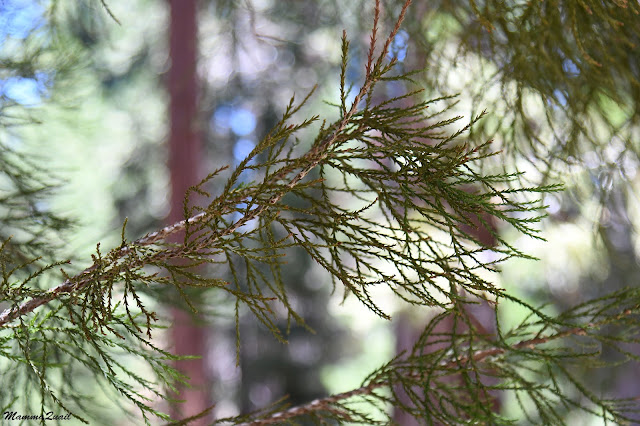




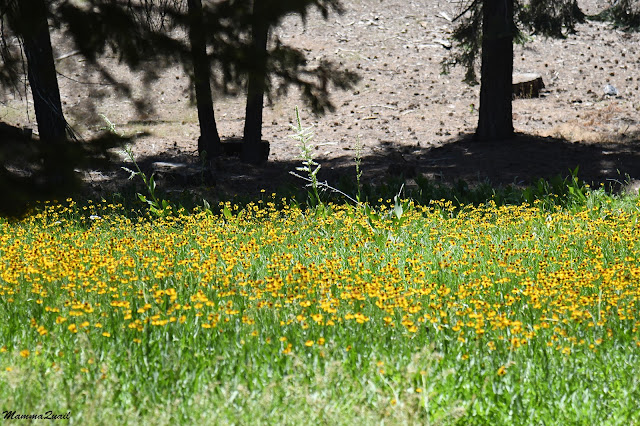










These giant trees are magnificent and amazing. The flowers around are a small bonus... Yael told me long ago the "blacked eye susan" is the common name for several different north american flowers
ReplyDeleteThe Giant Sequoia are one of Nature's best creations! These trees are amazing whichever way you consider them!
Delete